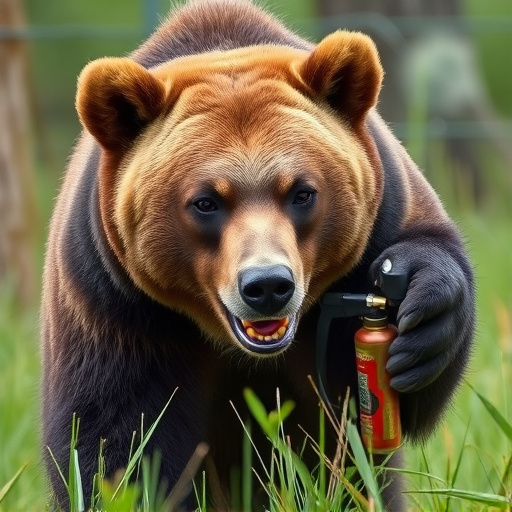Bear spray, a specialized pepper spray, uses capsaicin (oleoresin capsicum – OC) as its active ingredient to deter aggressive bears. Concentrations range from 2% to 30% OC, with lower percentages suitable for general outdoor activities and higher levels recommended for hazardous bear encounters. A minimum of 1.3% active ingredient percentage provides basic protection, while 2% or more is ideal for remote areas, giving users crucial time to safely retreat during potential bear interactions.
“In the vast wilderness, encounters with bears can be both awe-inspiring and dangerous. Here, we explore a critical tool in wildlife protection: bear spray. This article delves into the essentials of bear spray as a wilderness defense mechanism. From its historical origins to understanding the active ingredients and their effectiveness at varying percentages, we guide you through choosing the right bear spray for your adventures. Stay safe, stay informed.”
- Understanding Bear Spray: The Basics and Its History
- Bear Spray Active Ingredient: What's in the Mix?
- Determining Effective Bear Spray Percentage
- Choosing the Right Bear Spray for Your Wilderness Adventures
Understanding Bear Spray: The Basics and Its History
Bear spray, also known as bear deterrent or bear repellent, is a specialized pepper spray designed for use against bears in wilderness settings. Its primary purpose is to protect individuals and groups from unexpected encounters with aggressive bears by creating a barrier of protection during outdoor activities like hiking, camping, or hunting. The active ingredient in bear spray is capsaicin, the same chemical that gives chili peppers their heat. Typically, bear spray contains between 10% and 25% capsaicin, ensuring its effectiveness against bears.
The history of bear spray dates back to the late 20th century when wildlife managers and outdoor enthusiasts sought a non-lethal method to deter aggressive bear behavior. Early formulations were developed to address the growing concern over increasing bear-human conflicts, particularly in regions where grizzly bears (Ursus arctos horribilis) and black bears (Ursus americanus) coexist with humans. Over time, the technology has evolved, improving both the spray’s effectiveness and user safety. Today, bear spray is a widely adopted tool for wilderness protection, playing a crucial role in ensuring safer interactions between humans and bears in their natural habitats.
Bear Spray Active Ingredient: What's in the Mix?
Bear spray, a popular wilderness protection device, is an aerosol that delivers a potent mix of active ingredients designed to deter aggressive bears. The primary active ingredient in most bear sprays is capsaicin, derived from chili peppers. This substance creates a burning sensation when it comes into contact with the bear’s eyes, nose, and respiratory system, causing it to retreat.
The concentration of the bear spray active ingredient varies among brands, but typically ranges between 10% and 25%. This percentage determines the spray’s effectiveness and range. A higher concentration ensures a more powerful reaction, allowing for a greater distance from the bear. When choosing a bear spray, understanding the active ingredient percentage can help users make an informed decision based on their specific needs and the potential bear encounters they may face in the wild.
Determining Effective Bear Spray Percentage
When considering bear spray as a wilderness protection device, understanding the active ingredient percentage is paramount. The effectiveness of bear spray largely depends on the concentration of its key chemical component—typically oleoresin capsicum (OC). This natural compound derived from chili peppers is what causes bears to recoil. OC levels in bear spray range from 2% to 30%, with higher percentages generally offering more potent protection.
Choosing the right bear spray means selecting one that aligns with your specific needs and the potential bear encounters you might face. For instance, lower concentrations (around 4-8%) are suitable for general outdoor activities where bears are present but not overly aggressive. In contrast, 20% or higher OC levels are recommended for more hazardous situations, such as when hiking in grizzly bear country or during camping trips in remote areas known for aggressive black bears.
Choosing the Right Bear Spray for Your Wilderness Adventures
When considering bear spray as a wilderness protection device, one of the most crucial factors to evaluate is the active ingredient percentage. The effectiveness of bear spray largely depends on this concentration, with higher percentages offering greater deterrence against aggressive bears. Typically, bear sprays contain capsaicin, the active ingredient derived from chili peppers, which irritates a bear’s eyes and respiratory system.
Choosing a bear spray with a minimum Active Ingredient Percentage (AI%) of 1.3% is recommended for optimal protection during outdoor adventures. This concentration ensures that the spray creates a sufficient barrier against bears, providing users with valuable time to retreat or defend themselves. Higher AI% levels, such as those exceeding 2%, offer enhanced protection and are ideal for more remote or bear-infested areas.
Bear spray has established itself as a vital tool for wilderness protection, offering a safe and effective means of deterring bears. By understanding the active ingredient percentage, individuals can make informed decisions when choosing the right bear spray for their specific adventures. With the right knowledge, we can responsibly enjoy nature’s wonders while keeping ourselves and our environment safe.
